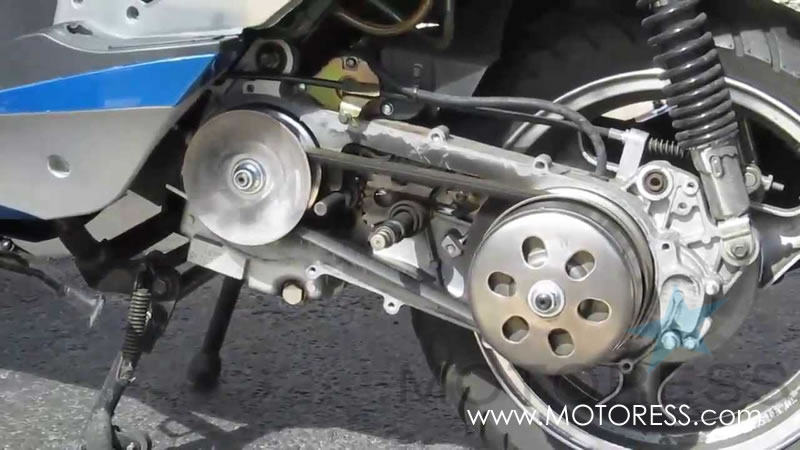Scooters are super fun—they’re easy to handle and described as simply “twist and go”. Scooters have climbed to high engine capacities and enjoyed by many not only in the city but on the highway. Even with their increased range of engine size availabilities, many are still surprised that indeed they’re automatic. They run using a CVT transmission a Continuously Variable Transmission meaning there’s no clutch or gear changing to do – fully automatic.
 CVT transmission- Continuously Variable Transmission
CVT transmission- Continuously Variable Transmission
And scooters surprise many riders of traditional transmission driven motorcycles who when jumping onto a scooter, often discover they’re over-shooting the road’s speed limit. This occurrence or shall we say “step-less acceleration” is arrived at by the CVT transmission.
The CVT type of transmission’s “gear ratios” automatically change within the limits of the system, to any random setting. It’s not constrained to a separate series of specific ratios such is typical of motorcycle transmissions. As a result, accelerating with a CVT is incredibly smooth uninterrupted process. You can indeed say that a CVT transmission has countless numbers of “gears” that it can run through at any time, at any engine or vehicle speed—and this makes it easy to go faster than you realize! When accelerating, the engine at first revs up to its comfortable RPM (revolutions per minute) range and then remains there while acceleration continues as the ratio changes to make wheel RPM faster while engine RPM remains the same.
CVT Transmission is Incredibly Smooth Uninterrupted Process
This of course is not the case when riding on a motorcycle using the traditional transmission. You gauge your speed by the engine’s speed-accomplished within one gear; always fixed and relative to each other. When changing to a CVT transmission propelled motorcycle, you’re not expecting vehicle speed to continue increasing while engine RPM’s remain constant. That’s why you may not notice as your speed increases (yes it’s a handy excuse if pulled over by police for accidentally going faster than you should be!)

The whole driving force in this system uses a belt between two pulleys—the effective radii are variable, changing according to the speed of the scooter; one radius increasing while the other decreases, accommodating its constant belt length. These belts stretch over time and as they loosen, slip and fail to transmit power to the wheel. Belt replacement is a standard maintenance task of the CVT powered motorbike.
The CVT transmission is also, aside from usual lighter weight of the scooter, the reason you’ll get much better fuel economy than the usual motorcycle transmission. The CVT enables the engine to run at its most efficient RPM for a range of vehicle speeds. This is achieved because the driving shaft maintains a constant angular velocity over a range of output velocities.
The simplicity and step-less nature of the CVT transmission have made them the perfect transmission for a variety of machines and devices-not only scooters. CVT’s have been used for years in power tools and drill presses-also in tractors and snowmobiles.
 CVT Transmission Low and High Gear
CVT Transmission Low and High Gear
There’s one challenge the CVT presents versus the standard manual motorcycle transmission – if you’ve got a dead battery you won’t be able to “bump start” your CVT driven motorcycle. Even though scooters are generally equipped with a kick-starter along with its electric ignition, it still won’t help in the case of a truly dead battery. An additional reason to pay extra attention to your battery’s maintenance.
Source: motoress